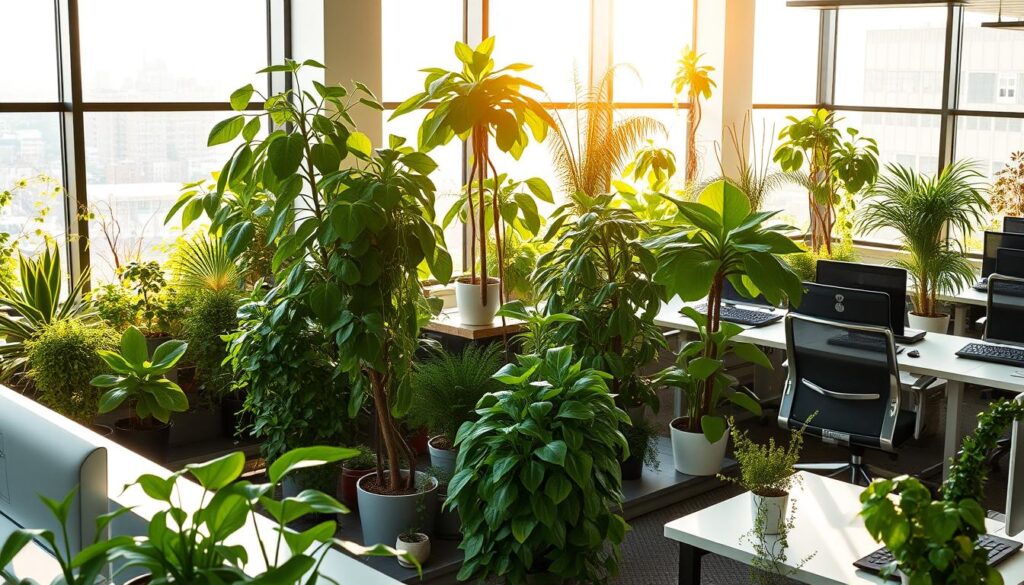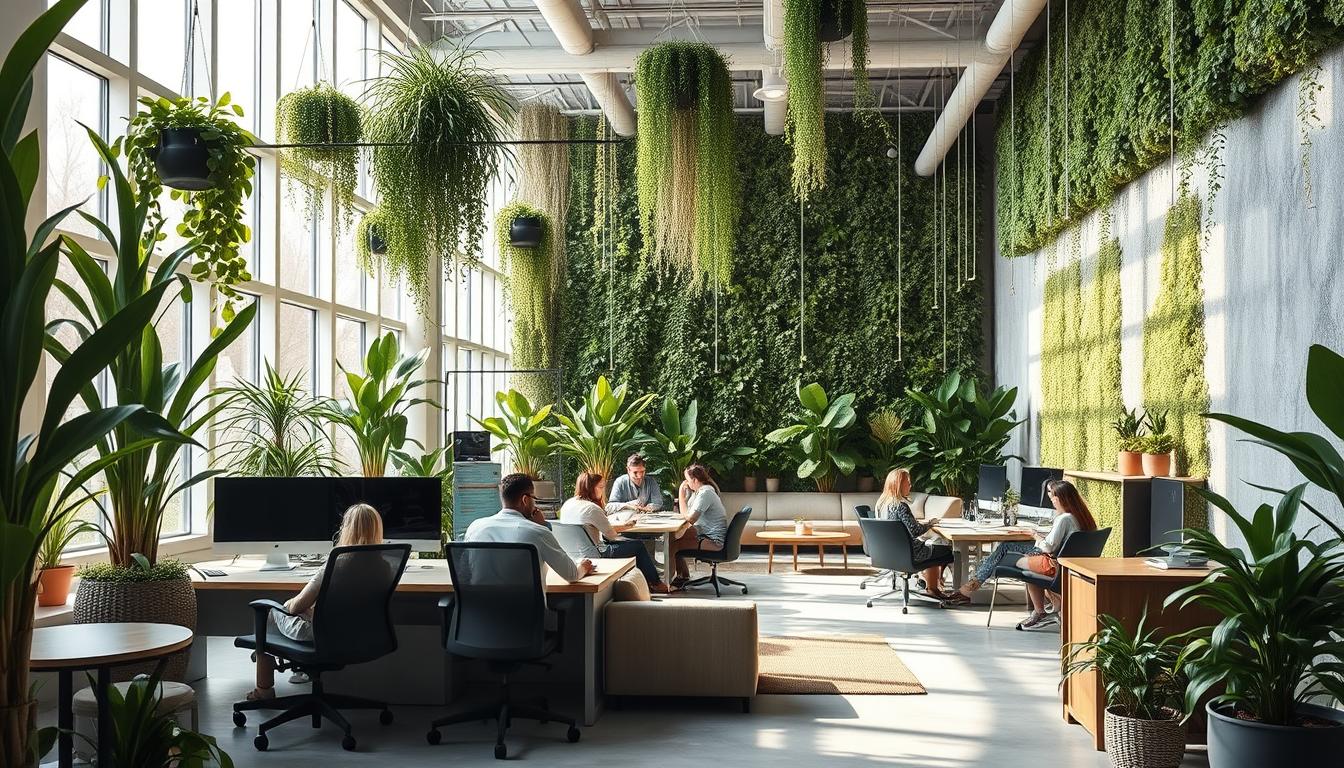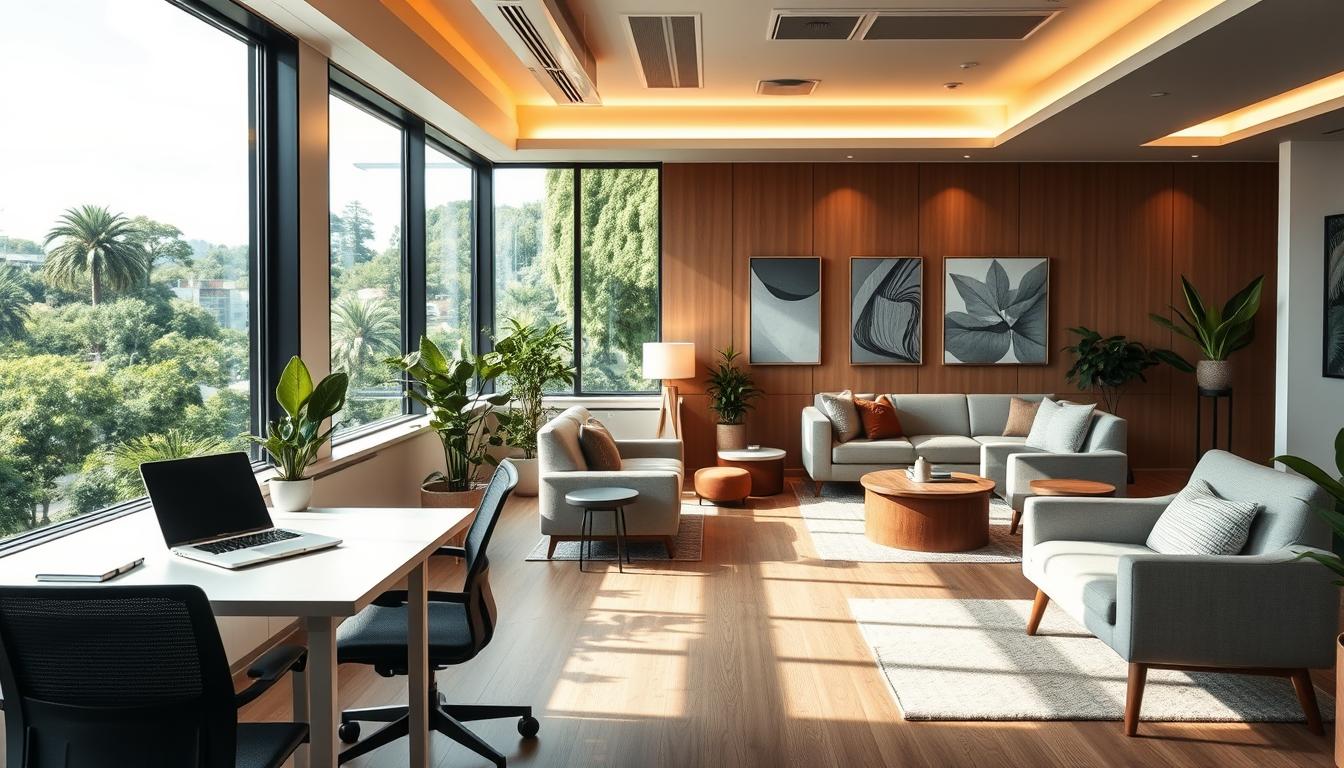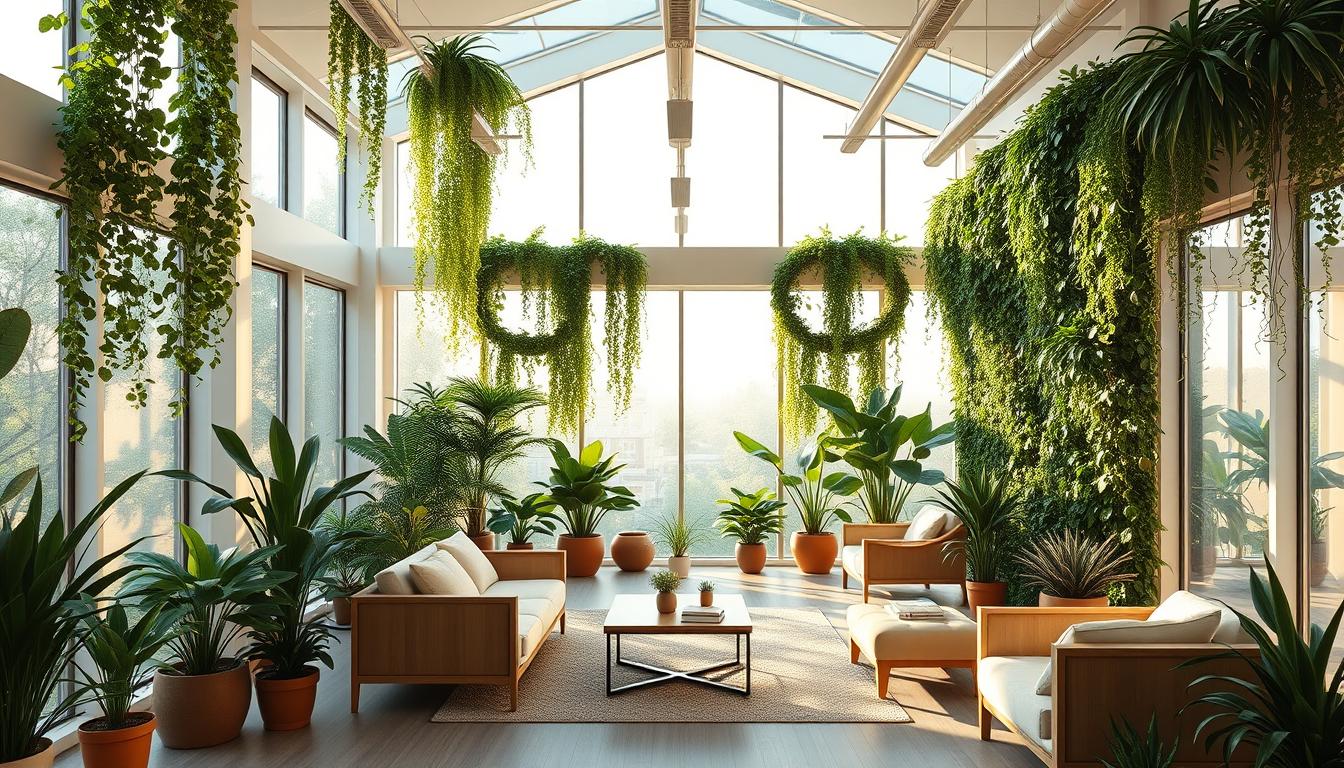In today’s work world, a biophilic office layout is super important. Adding nature into office design can majorly improve staff wellbeing and their work output. Studies show that people today spend up to 90% of their day inside. This flags a big need for office spaces that bring in nature.
A well-thought-out biophilic office layout does more than just make people feel good. It creates a welcoming space. This is key to have a happy and focused team at work.
Understanding Biophilic Design
Biophilic design brings nature into our work and living spaces. It’s based on our natural love for nature, a concept biologist Edward O. Wilson talked about in the 1980s. With cities growing fast, it’s key to know what biophilic design is. Most of us stay indoors, between 80-90% of our time. Adding nature to our offices, like plants, sunlight, and natural materials, makes our workspaces healthier.
What is Biophilic Design?
Biophilic design means creating spaces that fit our natural need to be around nature. It uses natural patterns and materials to make spaces welcoming. By adding things like green walls, big windows, and fresh air, it makes workplaces where people do well.
The Importance of Nature in Workplace Settings
Having nature in our work areas is great for our health. Workers around natural elements feel better and less stressed. This mood boost leads to being more productive and creative. Studies show places with a touch of nature help us physically and mentally. They also encourage us to connect with others, making a stronger, healthier workspace.

The Science Behind Biophilia
Studies show a strong link between nature and mental well-being. By bringing nature into indoor spaces, we see a boost in emotional health. This is key in workplaces adopting biophilic design to increase employee happiness and work performance.
Impact of Nature on Mental Health
Being around nature reduces anxiety, stress, and sad feelings. Research from top organizations shows people feel less stressed and happier in green areas. In fact, nature helps calm our minds, making it easier to think clearly and concentrate.
Benefits of Green Spaces in the Workplace
Nature in the office improves efficiency and creativity. Studies show that being around greenery helps employees think better. Adding plants to work spaces can increase creativity by 15%. This highlights how important biophilic research is. It proves that plants and green areas positively change how we work.
Biophilic Office Layout: Enhancing Employee Wellbeing
Designing a biophilic office layout boosts employee wellbeing. It makes workspaces feel peaceful by adding nature. This can turn a regular office into a space that feels comforting and inspired by nature.
Creating a Tranquil Environment
For a calming atmosphere, use natural elements. Things like indoor plants, water features, and plenty of sunlight are key. They make the office more peaceful, which helps employees feel relaxed, focus better, and stress less.
Elements to Include in a Biophilic Office
- Indoor plant walls that provide green visibility and purify the air
- Water installations that add soothing sounds and visual appeal
- Natural light sources that enhance mood and energy levels
- Natural airflow systems to improve air quality and circulation
- Acoustic elements that mimic natural sounds, further calming the space
Research shows these design features not only make the office more serene but also reduce employee sick days. Making spaces that care for employee wellbeing leads to happier staff and better health overall.
Boosting Creativity and Productivity Through Nature
Bringing nature into the workplace helps creativity and productivity. Green spaces and natural light make calming atmospheres. These environments help employees do their best.
Studies show that working in nature-like settings can increase productivity by up to 15%. This boost is because nature positively affects our mood and thinking.
Encouraging Collaboration with Natural Elements
Designs that include nature make workspaces feel open and friendly. Using plants and natural materials can inspire teamwork and new ideas. These spaces also make people feel at ease and encourage talking, which boosts creativity in groups.
When teams work in these environments, they work better together. This teamwork leads to successful projects.
Natural Light and Its Influence on Focus
Natural light is not just about looks. It can make us feel happier and more focused, which helps us work better. Bright, natural spaces prevent eye strain and tiredness.
Rooms with plenty of natural light turn boring offices into exciting places to work. This change can lead to better work and more creative ideas.
Reducing Stress and Burnout in the Workplace
Natural elements in the workplace help increase employee well-being. Adding these elements reduces stress and prevents burnout. A biophilic design, with plants and views of the outdoors, makes employees feel relaxed and focused.
How Natural Elements Alleviate Employee Stress
Bringing nature into the office can greatly lower stress for employees. Being around nature helps by:
- Encouraging relaxation and mental clarity.
- Lowering blood pressure and heart rate.
- Improving overall mood and emotional health.
These benefits lead to better work performance and coping skills. Biophilic design shields against the stress of fast-paced jobs.
Role of Indoor Plants in Reducing Anxiety
Indoor plants are key in lowering anxiety at work. They offer many benefits, including:
- Promoting tranquility.
- Improving air quality, which boosts brain function and health.
- Providing a nature vibe, even in cities.
Studies show that plants in offices don’t just reduce stress. They also stop burnout. The calming effect of plants helps everyone feel better. This leads to a happier and more effective work environment.
Attracting and Retaining Talent with Biophilic Spaces
In today’s job market, companies need to stand out to attract top talent. Using biophilic design helps in hiring new people and boosts employee happiness. A workspace with nature in mind is more inviting. This can catch the eye of great candidates, making a company attractive. By focusing on employee well-being with smart design, companies create a culture of comfort and productivity.
The Competitive Job Market
The battle to draw in skilled workers is fiercer than ever across fields. Companies now see how important workspace looks are for drawing job seekers. Benefits of biophilic design, like more natural light and plants, improve the work setting. Job seekers often see these features as signs of a company caring for its employees’ well-being and balance. This can sway their choice to join or stick with a firm.
Employee Satisfaction and Retention Rates
Keeping employees happy is vital for retaining them. Workplaces with biophilic elements tend to see fewer people leave. Workers often prefer offices that value their comfort and wellness with natural designs. This loyalty reduces the cost of replacing staff.
Environmental Sustainability in Biophilic Design
Adding environmental sustainability to biophilic design makes workspaces healthier. It boosts biodiversity in office settings, improving both the ecological footprint and worker wellbeing. Using local plants supports nearby ecosystems and helps people feel closer to nature.
Promoting Biodiversity within Office Spaces
Bringing various local plants into office areas is key. This move brings many pluses, like:
- Improved air quality through natural filtration.
- Increased aesthetic appeal that boosts employee morale.
- Support for local wildlife, promoting ecological balance.
This creates a lively work place. It also shows how vital biodiversity is in city areas.
Sustainable Materials for Biophilic Design
The materials used affect biophilic design’s sustainability. Choosing reclaimed wood and natural stone lowers the carbon footprint. Important points include:
- Prioritizing renewable resources that minimize environmental disturbance.
- Choosing products with low environmental impact during production.
- Incorporating finishes and adhesives that align with sustainable design principles.
These steps lead to a workplace that looks good and works well. They also show a strong commitment to eco-friendly design. This positive impact shapes how employees think about the environment.
Implementing Biophilic Design: Practical Tips
To make a biophilic office, plan carefully. Focus on the layout to blend nature into work areas. Aim for spaces that meet different needs and boost well-being and work performance.
Key Features for a Biophilic Office Layout
Adding certain elements to your office can make employees happier. Here are some biophilic tips to try:
- Utilize natural light through big windows or skylights. This boosts mood and focus.
- Integrate flexible furniture that can change based on the team’s needs and tasks.
- Incorporate indoor plants for a calming environment and better air quality.
- Design green communal areas that encourage team members to work together and socialize.
- Use natural materials in flooring and decor to bring outdoor beauty inside.
Adapting Spaces for Different Work Activities
Not every task needs the same setting. Recognizing this helps create versatile workspaces that increase productivity:
- Set up quiet zones for focus, using soundproof materials and comfy seats.
- Design teamwork areas with whiteboards and movable seating to boost collaboration.
- Create breaks areas with plants for employees to recharge.
- Incorporate tech-friendly areas with charging spots and fast internet for easy task shifts.
Conclusion
Using biophilic design in offices is more than a trend. It’s a way to make work better for everyone. It helps workers feel healthier, do better at their jobs, and feel happier overall. When offices bring in nature, people enjoy their jobs more and stay longer.
We should push for better-designed workplaces. Future offices will focus more on bringing the outdoors in. By adding plants, sunlight, and natural materials, workplaces become more lively. Employees get more involved, and it’s also good for the Earth.
Companies should really get behind biophilic design. It makes work life better and helps the company culture grow stronger. This way, workplaces become places that care for both people and our planet.



